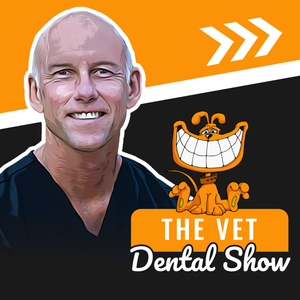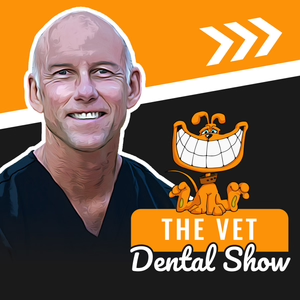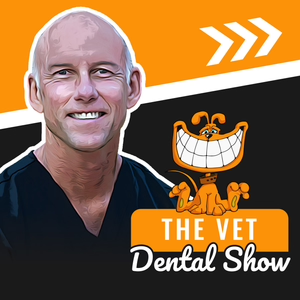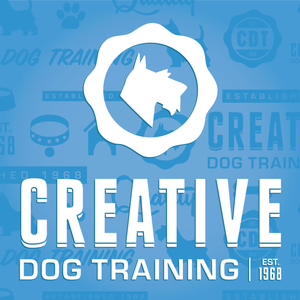
Ep 138 - What Are the Best Practices for Treating Gingival Hyperplasia in Dogs?
07/31/24 • 11 min
In this episode of the Vet Dental Show, Dr. Brett Beckman, Board Certified Veterinary Dentist, answers listener questions about managing gingival hyperplasia in boxers and other brachycephalic breeds. Dr. Beckman discusses the importance of radiographs before treatment, when to refer complex cases, and the nuances of dealing with epulides. Tune in for expert advice and practical tips to enhance your veterinary dental practice.
Guest, Cast, and Crew Information- Host: Dr. Brett Beckman, Board Certified Veterinary Dentist
- Sponsor: Veterinary Dental Practitioner Program
- Introduction: Overview of the episode and sponsorship details.
- Listener Question: Mandy's question on treating gingival hyperplasia in boxers.
- Radiographs Importance: The necessity of taking radiographs before treatment.
- Treatment Approach: Steps to handle gingival hyperplasia and epulides.
- When to Refer: Guidance on referring complex brachycephalic cases.
- Histopathology: The importance of submitting tissue for histopathology.
- Maintenance and Follow-Up: Managing recurrent gingival hyperplasia.
- "You do not want to go in and start removing tissue without first taking radiographs."
- "Brachycephalic breeds often have dense cortical bone, making extractions more challenging."
- "Gingival hyperplasia will come back and requires maintenance every 6 to 18 months."
- 00:00 - 00:30: Introduction
- 00:31 - 02:00: Listener Question from Mandy
- 02:01 - 04:00: Importance of Radiographs
- 04:01 - 06:00: Treatment Approach for Gingival Hyperplasia
- 06:01 - 08:00: When to Refer Complex Cases
- 08:01 - 10:00: Histopathology and Tissue Submission
- 10:01 - 11:30: Maintenance and Follow-Up
- 11:31 - 13:00: Summary and Conclusion
[Veterinary dentistry, gingival hyperplasia, brachycephalic breeds, radiographs, dental extractions, epulides, histopathology, veterinary dental training, Dr. Brett Beckman]
Key Points Summary- Radiographs Importance: Always take full mouth radiographs before treating gingival hyperplasia.
- Treatment Approach: Remove affected teeth and contour tissue for closure.
- Referral Guidance: Refer complex brachycephalic cases to specialists.
- Histopathology: Submit all excised tissue for pathology to ensure an accurate diagnosis.
- Maintenance: Regular follow-up and maintenance are necessary for managing recurrent gingival hyperplasia.
- IVDI.org/inv - Submit your request for an invitation to the Veterinary Dental Practitioner Program.
In this episode of the Vet Dental Show, Dr. Brett Beckman, Board Certified Veterinary Dentist, answers listener questions about managing gingival hyperplasia in boxers and other brachycephalic breeds. Dr. Beckman discusses the importance of radiographs before treatment, when to refer complex cases, and the nuances of dealing with epulides. Tune in for expert advice and practical tips to enhance your veterinary dental practice.
Guest, Cast, and Crew Information- Host: Dr. Brett Beckman, Board Certified Veterinary Dentist
- Sponsor: Veterinary Dental Practitioner Program
- Introduction: Overview of the episode and sponsorship details.
- Listener Question: Mandy's question on treating gingival hyperplasia in boxers.
- Radiographs Importance: The necessity of taking radiographs before treatment.
- Treatment Approach: Steps to handle gingival hyperplasia and epulides.
- When to Refer: Guidance on referring complex brachycephalic cases.
- Histopathology: The importance of submitting tissue for histopathology.
- Maintenance and Follow-Up: Managing recurrent gingival hyperplasia.
- "You do not want to go in and start removing tissue without first taking radiographs."
- "Brachycephalic breeds often have dense cortical bone, making extractions more challenging."
- "Gingival hyperplasia will come back and requires maintenance every 6 to 18 months."
- 00:00 - 00:30: Introduction
- 00:31 - 02:00: Listener Question from Mandy
- 02:01 - 04:00: Importance of Radiographs
- 04:01 - 06:00: Treatment Approach for Gingival Hyperplasia
- 06:01 - 08:00: When to Refer Complex Cases
- 08:01 - 10:00: Histopathology and Tissue Submission
- 10:01 - 11:30: Maintenance and Follow-Up
- 11:31 - 13:00: Summary and Conclusion
[Veterinary dentistry, gingival hyperplasia, brachycephalic breeds, radiographs, dental extractions, epulides, histopathology, veterinary dental training, Dr. Brett Beckman]
Key Points Summary- Radiographs Importance: Always take full mouth radiographs before treating gingival hyperplasia.
- Treatment Approach: Remove affected teeth and contour tissue for closure.
- Referral Guidance: Refer complex brachycephalic cases to specialists.
- Histopathology: Submit all excised tissue for pathology to ensure an accurate diagnosis.
- Maintenance: Regular follow-up and maintenance are necessary for managing recurrent gingival hyperplasia.
- IVDI.org/inv - Submit your request for an invitation to the Veterinary Dental Practitioner Program.
Previous Episode

Ep 137 - Maximising Efficiency in Veterinary Dentistry: The Importance of a Distraction-Free Environment
In this episode of the Vet Dental Show, Dr. Brett Beckman, Board Certified Veterinary Dentist, explores how minimising distractions can significantly enhance your productivity in veterinary dentistry. Dr. Beckman shares insights on creating a focused environment, managing technology-induced distractions, and achieving a flow state for peak performance. Learn practical tips to implement these strategies in your daily routine and improve both your professional and personal life.
Guest, Cast, and Crew Information- Host: Dr. Brett Beckman, Board Certified Veterinary Dentist
- Sponsor: Veterinary Dental Practitioner Program
- Introduction to the Episode: Overview of performance improvement topics.
- Importance of a Focused Environment: Creating an optimal space for dental procedures.
- Managing Technology Distractions: Tips for reducing phone and device interruptions.
- Achieving Flow State: The science behind uninterrupted work and its benefits.
- Practical Tips: Implementing these strategies in daily practice.
- Impact on Overall Performance: How these techniques can improve productivity and patient care.
- "Distractions during procedures can compromise patient safety and efficiency."
- "Achieving a flow state can increase your productivity by up to 500%."
- "Eliminating device interruptions is crucial for maintaining focus in the operatory."
- 00:00 - 00:30: Introduction
- 00:31 - 02:00: Creating a Focused Environment
- 02:01 - 04:00: Managing Technology Distractions
- 04:01 - 06:00: Achieving Flow State for Peak Performance
- 06:01 - 08:00: Practical Tips for Daily Implementation
- 08:01 - 10:00: Impact on Overall Performance
- 10:01 - 11:30: Summary of Key Points
- 11:31 - 13:00: Conclusion and Call to Action
[Veterinary dentistry, eliminating distractions, peak performance, flow state, productivity tips, managing technology, focused environment, veterinary dental training, Dr. Brett Beckman]
Key Points Summary- Focused Environment: Essential for efficient dental procedures and patient safety.
- Managing Technology: Reduce phone and device interruptions to maintain focus.
- Flow State: Achieving uninterrupted work periods can dramatically increase productivity.
- Practical Tips: Implement strategies to minimise distractions in your daily routine.
- Overall Performance: Improved focus leads to better patient care and personal efficiency.
- IVDI.org/inv - Submit your request for an invitation to the Veterinary Dental Practitioner Program.
Next Episode

Ep 139 - From Dental Radiographs to Mentorship: An Interview with Dr. Trudy Bowden
Summary
In this episode of the Vet Dental Show, Dr. Brett Beckman, Board Certified Veterinary Dentist, interviews Dr. Trudy Bowden, a long-time friend, colleague, and accomplished general practitioner. Dr. Bowden shares her inspiring journey from rekindling her passion for dentistry to becoming a key player in her practice's dental services. They discuss overcoming challenges, the importance of continuous learning, and the rewarding nature of veterinary dentistry. Tune in for an insightful conversation filled with practical tips and motivational stories.
Guest, Cast, and Crew Information- Host: Dr. Brett Beckman, Board Certified Veterinary Dentist
- Guest: Dr. Trudy Bowden, Veterinary Dental Practitioner Program
- Sponsor: Veterinary Dental Practitioner Program (IVDI)
- Introduction: Overview of the episode and sponsorship details.
- Guest Introduction: Dr. Trudy Bowden’s background and journey in veterinary dentistry.
- Initial Challenges: Overcoming the initial lack of confidence and building skills.
- Impact of Dental Radiographs: The transformative effect of implementing dental x-rays in practice.
- Professional Growth: Continuous learning through courses and mentorship.
- Balancing Life and Career: Managing professional growth while raising a family.
- Health Scare and Reassessment: Reprioritising life and career goals after a health scare.
- Importance of Passion and Purpose: Finding and pursuing a passion for dentistry.
- Transition to a New Practice: Moving from a lead role in a small practice to a learner in a larger hospital.
- Teaching and Mentoring: The rewards of teaching and continued learning.
- "What would you do if you weren't afraid? I want to do dentistry full time."
- "We knew we were missing pathology, we just didn't know how much we were missing."
- "The return on investment professionally and personally is just without compare."
- 00:00 - 00:30: Introduction
- 00:31 - 01:30: Guest Introduction - Dr. Trudy Bowden
- 01:31 - 03:00: Overcoming Initial Challenges
- 03:01 - 04:30: Implementing Dental Radiographs
- 04:31 - 06:00: Continuous Learning and Professional Growth
- 06:01 - 08:00: Balancing Life and Career
- 08:01 - 09:30: Health Scare and Reassessment
- 09:31 - 11:00: Importance of Passion and Purpose
- 11:01 - 12:30: Transition to a New Practice
- 12:31 - 13:00: Teaching and Mentoring
[Veterinary dentistry, dental radiographs, professional growth, veterinary dental practitioner, balancing life and career, passion in veterinary practice, continuous learning, teaching and mentoring, Dr. Brett Beckman, Dr. Trudy Bowden]
Key Points Summary- Introduction: Welcoming listeners and introducing the guest, Dr. Trudy Bowden.
- Guest Background: Dr. Bowden’s educational background and journey in veterinary dentistry.
- Initial Challenges: Building confidence and skills through courses and mentorship.
- Dental Radiographs: The significant impact of introducing dental x-rays in her practice.
- Professional Growth: Continuous learning through seminars and mentorship programs.
- Balancing Life: Managing a professional career while raising a family.
- Health Reassessment: Reprioritising goals after a health scare.
- Passion and Purpose: The importance of finding and pursuing a passion for dentistry.
- Transition: Moving to a larger hospital and continuing to learn and teach.
- Teaching: The rewards and challenges of teaching and mentoring others.
- IVDI.org/INV - Submit your request for an invitation to the Veterinary Dental Practitioner Program
The Vet Dental Show - Ep 138 - What Are the Best Practices for Treating Gingival Hyperplasia in Dogs?
Transcript
Welcome to the Vet Dental Show. I'm Brett Beckman, board certified veterinary dentist. And we bring this podcast to you every Wednesday as a veterinarian, as a technician, as a dentistry team to help you be even better in veterinary dentistry and your practice. We're sponsored and partnered today with the veterinary dental practitioner program. If you're interested in being among the best anywhere in general practice as a team in veterinary dentistry, I invite you to
If you like this episode you’ll love
Episode Comments
Generate a badge
Get a badge for your website that links back to this episode
<a href="https://goodpods.com/podcasts/the-vet-dental-show-478978/ep-138-what-are-the-best-practices-for-treating-gingival-hyperplasia-i-65262084"> <img src="https://storage.googleapis.com/goodpods-images-bucket/badges/generic-badge-1.svg" alt="listen to ep 138 - what are the best practices for treating gingival hyperplasia in dogs? on goodpods" style="width: 225px" /> </a>
Copy




